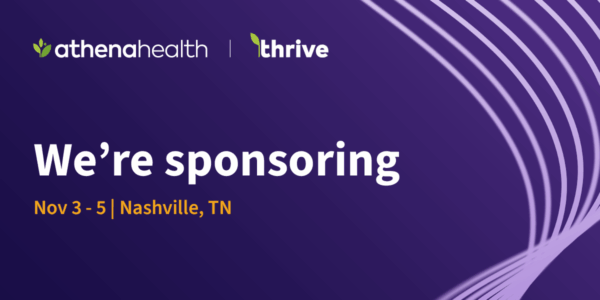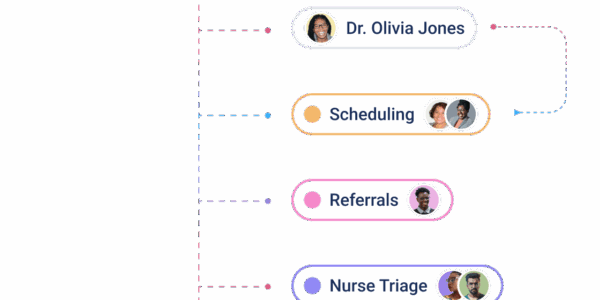TL;DR — Assort Health vs. OhMD (Quick Comparison)
| Category |

|

|
|---|---|---|
| Founded | 2016 | 2023 |
| Adoption | Trusted by 50,000+ providers across specialties | Live in ~140 clinics, heavy in ortho/cardiology |
| Core Platform Approach | AI-native, omni-channel (voice, text, chat, video, forms) with human-in-the-loop | Voice-first AI receptionist, focused on call resolution |
| How Automation Works | Automates 100% of routine calls but escalates when empathy/expertise needed | Claims to handle 90%+ calls end-to-end; staff step in mainly when AI fails |
| Integrations | 85+ EHRs, can be embedded in athenahealth, athenahealth Accelerate Partner (4.9 stars) | Lists Epic, athenahealth, Cerner, ModMed, AdvancedMD |
| Results | 60% drop in call volume; 13% fewer no-shows (≈$75k saved per provider annually) | Hold times cut from 11 min → 1 min; abandonment down >50% |
| Pricing / Go-Live | Starting at $500/mo, live in ~1 week | ~$1,500/mo+; 3–5 weeks to go-live |
| Best Fit | Practices wanting multi-channel AI with staff context preserved | Clinics prioritizing phone automation and specialty call flows |


AI voice + texting in one platform. Fewer no-shows, less phone time.
👉 Book a demo today and see how OhMD keeps patients happy and staff stress-free.
Patients today feel the cracks in the healthcare experience before they ever see a doctor.
Nine out of ten appointments still happen by phone. Patients sit on hold. They repeat themselves. Some just hang up. For staff, it’s no better. The phones never stop. They’re pulled in every direction, mistakes slip through, and the stress drives some to burnout.
Every missed call or long wait has a cost – canceled visits, no-shows, and lost revenue. Smaller teams and high turnover make it worse, while patients expect faster responses than ever before. The traditional phone call just doesn’t work the way it once did.
This is the reality:
- Patients often end up waiting on hold, and when scheduling feels complicated, frustration builds fast.
- Staff get buried in repetitive calls. They get worn down. Errors creep in. Some burn out and leave.
- Practices lose money every day from missed appointments, abandoned calls, and inefficient workflows.
- Patient experience declines, especially for those with urgent needs.
- The cycle continues – and in many places, it’s getting worse.
That’s why AI-driven communication tools are getting so much attention. OhMD and Assort Health represent two very different approaches to the same problem. One is an AI-native, omni-channel communication platform that keeps humans in the loop for patient communication. The other is a specialty-specific, voice-only AI receptionist that automates as much of the phone call as possible. Both aim to solve the same pain points – but with very different philosophies.
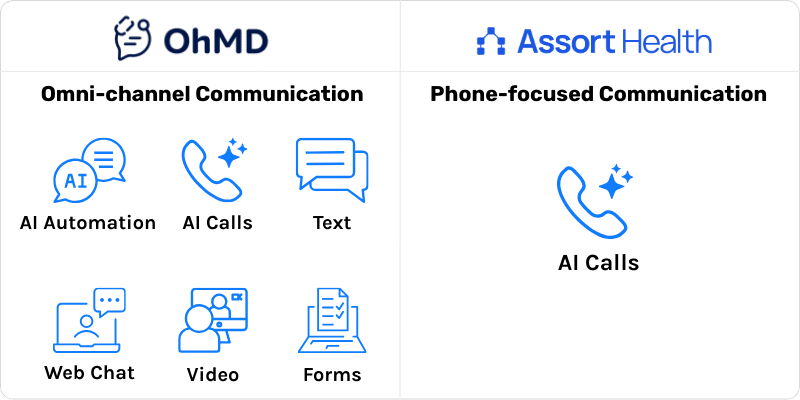
We’ll compare OhMD and Assort Health across features, outcomes, patient experience, and ROI. Our goal is to give practices the data they need to choose wisely – whether they’re considering OhMD, researching Assort Health, or comparing Assort Health competitors.
The Impact of High Call Volume on Staff and Patient Experience
Staff Experience (Workload, Stress)
- The Association of American Medical Colleges (AAMC) projects a shortfall of up to 86,000 doctors by 2036.
- Front desk and call center turnover runs 30% to 45%, which extends hold times and slows service.
- Same-day demand is rising while teams juggle chronic care, telehealth, approvals, and digital tools training.
Patient Experience (Frustration, Delays)
- Average hold time is 4.4 minutes vs a 50-second benchmark. About 60% won’t wait longer than a minute. Only about a third ever call back.
- Even though many patients prefer digital tools, roughly 88% of appointments are still booked by phone.
- No-show rates in outpatient care often range from 12% to 42%, with some clinics higher. That hurts revenue and access.
Company Snapshots
OhMD vs. Assort Health at a Glance
| Company | Founded | Core Product | Key Strengths | Adoption |
|---|---|---|---|---|

|
2016 | AI voice and workflow assistant (Nia) + text-based patient communication | Omni-channel (human-in-the-loop AI, voice, SMS, chat, video), 85+ EHR integrations, fast deployment | Trusted by 50,000+ providers, from solo practices to large health systems |

|
2023 | AI voice receptionist | Specialty-specific workflows, claims 90%+ resolution, 80+ EHR integrations | Live in about 140 clinics, with focus on orthopedics and cardiology |
OhMD Overview
- Founded in 2016
- Trusted by more than 40,000 healthcare providers nationwide; recognized as a Leader in HIPAA-compliant messaging by G2
- Provides AI-Native omni-channel patient communication including the Nia voice AI and AI assisted HIPAA-compliant texting, broadcast messaging, forms, and telehealth in one platform
- Automates 100% of the calls you don’t want your staff handling – with AI that knows when to escalate to a human
Assort Health Overview
- Founded in 2023
- Serves ~140 clinics, with deep focus on specialties like Orthopedics and Cardiology
- Provides AI voice agents that act as virtual receptionists for specialty clinics
- Reported 90%+ call resolution and 99% scheduling accuracy
How Each Platform Works
Communication Channels
OhMD: An AI-native omni-channel platform built for real patient conversations. It brings together voice, text, web chat, video, forms, and more so everything lives in one place. At the heart is Nia, our voice AI that works alongside your team. Keeping the human *hero in the loop, Nia automates 100% of the calls you don’t want staff handling and is smart enough to escalate when a human touch is needed. Patients don’t need to wait on hold. They can text the office securely, reply to reminders, complete forms, or start a telehealth visit. And when someone does call, Nia picks up on the first ring and, if it’s easier, keeps the conversation going over text. It’s like giving your team superpowers.
Hear what Nia sounds like…
Assort Health: A voice-first AI that works like a virtual receptionist for medical practices. Patients call in and the system can schedule, change, or cancel appointments, answer common questions, and route calls. But it’s mostly limited to the phone channel. Texting is used for simple follow-ups, not true two-way messaging, and it doesn’t extend into forms, broadcasts, or other tools practices rely on. That makes it more of a point solution for calls than an omni-channel platform.
AI Approach
OhMD: Nia takes 100% of the routine calls off the plate of staff. That includes all scheduling, prescription refills, and common questions that otherwise bog down the front desk. Every one of these calls is managed by the AI, giving teams relief from the constant interruptions.
When a call requires more than a straightforward answer, Nia doesn’t try to force it. It passes the call to the right person so patients benefit from the knowledge and skill of clinical or administrative staff. Practices get complete coverage for routine requests without losing the human touch where it matters most.
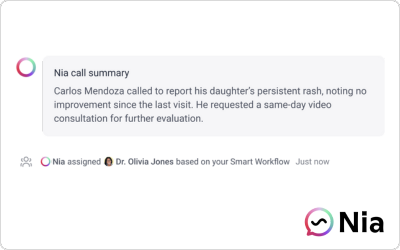
Assort Health: Assort Health positions its AI around call resolution. The company reports that its system can complete more than 90 percent of calls end-to-end, sending only the remainder to staff. While this drives efficiency, it leaves less flexibility for staff expertise to guide interactions when situations are more complex or sensitive.
Integration
OhMD: Connects with over 85 EHR systems, so whether you run a large clinic or a solo practice, your tools and patient conversations stay in sync. OhMD is part of a select group as an athenahealth Accelerate Partner, earning a 4.9-star rating in the Marketplace. You’ll also find us in the marketplaces for AdvancedMD, ModMed, Veradigm/Allscripts, Healthie, and Trizetto. These listings show that OhMD is established and trusted across the health tech ecosystem. For the full list of integrations, visit OhMD EHR integrations.
Assort Health: Assort lists integrations with systems like Epic, athenahealth, Cerner, AdvancedMD, and ModMed. While that allows its AI to book directly into a practice’s schedule, the focus stays narrow – it powers the phone channel, not a full range of communication like texting, forms, or broadcast messaging.
Adaptable Workflows vs. Fixed Scripts
OhMD: Nia can run specialty-specific scripts when practices want that precision, but it isn’t locked into them. Every interaction – whether handled by Nia or by staff – lives in the same consolidated patient chat record. That means context is continuous across phone, text, forms, and telehealth, so nothing is ever siloed.
Why does that matter? When tools don’t connect, things get missed. Patients wait, and care suffers. OhMD pulls it all into a single thread so staff can see what’s happening and jump in at the right time.
With OhMD, staff always see the full picture and can add their expertise at the right time, whether the issue is clinical or administrative. The result is adaptable workflows with human oversight built in.
Assort Health: Assort Health takes the opposite approach. Its AI is designed around specialty-specific call flows, particularly in orthopedics, cardiology, and dermatology. The goal is 100 percent AI resolution, with staff only involved if the system fails. This makes it effective for narrow specialty use cases, but it creates siloed automation – the phone channel operates on its own, separate from other communication tools practices rely on.
Outcomes That Matter: OhMD vs. Assort Health
What can you expect?
| Metric |

|

|
|---|---|---|
| Handling Routine Calls | Nia takes every routine call off the staff’s plate – from scheduling to refills to common questions. In pilots, that cut overall call volume by about 60% and gave teams back as much as five hours in a day. | Claims around 9 out of 10 calls are closed by the AI. The ones it can’t complete are sent along to staff. |
| Impact on Patient Experience | Calls can be answered by Nia or moved into secure two-way text. Patients are not locked into automation, and staff see the whole conversation in one place. | Voice-only resolution model. Patients interact with the AI on the phone – with limited support for other channels. |
| Financial Outcomes for Practices | At one pediatric clinic, no-shows dropped by 13%. That worked out to roughly $75,000 in revenue kept per provider each year. | Reports efficiency gains from faster call resolution and lower abandonment, but no published figures on revenue impact. |
| Impact on Staff Workload | Front desk teams avoid repetitive calls and can focus on patients in the office, which lowers stress and reduces turnover risk. | Staff are mainly a fallback, not an integrated part of the workflow. For some orthopedic and cardiology groups, the call burden drop is the draw. |
OhMD’s Results
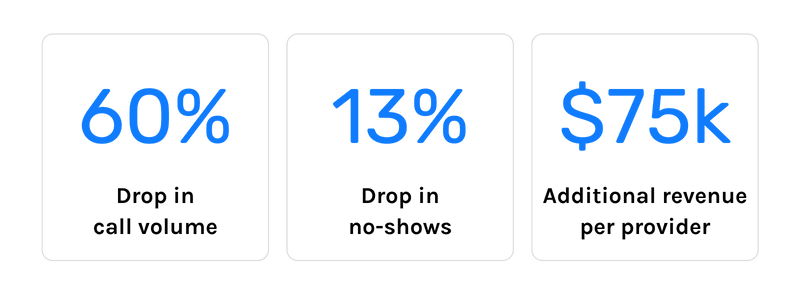
- In pilot clinics, Nia took on 100% of routine calls – scheduling, refills, and common questions – and that drove a 60% drop in total call volume. For some teams, that meant giving staff back as much as five hours a day to focus on patients in the office.
- Unlike AI systems focused only on call resolution, OhMD gives practices the choice to resolve calls or deflect them into secure two-way text. One family practice used this approach and cut its call volume in half, proving the power of an omni-channel model where both calls and texts can be AI-assisted and managed in the same patient record.
- The benefit goes beyond fewer calls – it shows up directly in the bottom line. One pediatric clinic reduced no-shows by 13% – that’s roughly one out of every eight missed visits avoided. With nearly 500 visits per month typical for a pediatric provider, that meant about 62 more visits kept each month. At $100 per visit – roughly in line with the national average of $105 for outpatient visits, that added up to roughly $75,000 in additional annual revenue per provider that would have otherwise been lost.
- The biggest change shows up inside the practice itself. Staff tell us the biggest relief is not chasing phone calls all day. When those interruptions drop off, the job feels less stressful and they can put more energy into the patients in front of them.
→ Together, these results show that OhMD goes beyond call coverage. Practices see stronger patient access, steadier revenue, and teams that feel less drained.
Assort Health’s Results
- Assort Health says its AI voice agents can handle more than 90% of calls on the first try. Most of those calls never make it to staff at all.
- Specialty clinics using the platform report that they have seen hold times fall by almost 90% – from about 11 minutes down to just 1. Patients get answers faster and spend less time waiting.
- Shorter waits also meant fewer people hung up. Call abandonment fell by more than half, so more patients stayed on the line and were able to schedule or confirm appointments.
- In some orthopedic groups, more than half of daily call volume was taken over by the AI system. While that moved a large share of calls off staff, the interactions stayed siloed on the phone. Reviews of Assort Health often note this is a strength for practices that only want call coverage, but a limitation for groups looking for more flexibility.
→ These results show how Assort can improve efficiency in specialty practices through phone automation, but its impact stops at call resolution rather than extending across a full, omni-channel system.
Here’s the bottom line:
Both platforms can make a practice run more smoothly, but they go about it in very different ways. Assort Health leans hard on automation, aiming to handle nearly everything by AI. OhMD takes a different path. It lets the AI manage the routine calls, but makes sure staff stay involved when their knowledge or judgment is needed.
Assort Health pricing and ROI vs OhMD
What will OhMD vs Assort Health cost me?
| Category |

|

|
|---|---|---|
| Pricing model | Predictable pricing starting at $500/month. Start with texting, add AI voice, chat, or workflows later. | Starts around $1,500/month for small clinics. Can reach five figures for larger groups. |
| Go-live timeline | Typically live in about a week. No hardware. No IT lift. | Third-party reviews put go-live at 3–5 weeks. |
| Upfront cost | Minimal. Most of the investment is subscription only. | Higher upfront spend, especially if replacing call center staffing. |
| ROI drivers | Fewer no-shows (13% drop in pediatrics ≈ $75k/year per provider). Staff time shifts back to patient care. Happier patients. | Efficiency gains from faster call resolution and lower abandonment. Revenue impact not widely reported. |
OhMD pricing
Simple pricing, starting at $500 per month for the Automate tier. Start with texting. Add AI voice, chat, or workflows later. No hardware. No heavy IT. Most practices are live in about a week. The benefits show up fast – fewer missed appointments, smoother messages, and staff time shifting back to face-to-face care. Exactly what you want for your staff and patients.
Assort Health pricing
Third party reviews put go-live at roughly 3 to 5 weeks. Assort Health pricing typically starts around $1,500 per month for smaller clinics and can scale to five figures for larger groups based on calls and configuration. Replacing a call center can offset some of that. The upfront number is larger – but for practices seeking a full Assort Health alternative to live staff, that cost may feel justified. That’s why many reviews of Assort Health describe it as a competitor to traditional call center staffing.
Which path fits your practice?
- Automate most phone work and treat it as a staffing offset – that’s Assort’s pitch.
- Use AI across calls, text, and workflows with your team still in the loop – that’s OhMD. It takes routine calls off the plate, helps keep revenue from scheduled visits, lifts patient satisfaction, and scales across every channel you run.
Patient and Staff Experience with OhMD and Assort Health
Impact on patients
OhMD
- Call comes in. Nia answers right away.
- Handles the simple stuff – refill, appointment, directions.
- Patient wants text instead? Flip to SMS, no hold music.
- Needs a human? Staff jump in with full context, nothing lost.
Assort Health
- Voice first. Automation covers most calls.
- Less flexible if patient wants another channel.
- Transition can be messy. Patients repeat themselves.
Impact on staff
OhMD
- Routine calls? Nia takes all of them.
- Staff only handle cases that need judgment or clinical input.
- When they do step in, full context is there. No guessing.
- Fewer interruptions. More focus on patients in the office.
- Phone tag gone. Morale goes up.
Assort Health
- AI handles most calls start to finish.
- Staff workload lighter, but only steps in when AI fails.
- Can feel like giving up control of patient communication.
Which Should You Choose?

OhMD and Assort Health are both tackling the same challenge, but the way they do it couldn’t be more different.
Choose OhMD if you want:
- Calls answered right away by an AI assistant that handles 100% of routine requests, with a smooth handoff to staff when expertise is needed
- Patients to have choice in how they connect – call, text, chat, video – not just voice-only
- A human-in-the-loop AI model that protects safety and keeps empathy in every interaction
- Fast deployment, predictable pricing, and ROI proven across practices of all sizes
- A platform that grows with you, from solo providers to enterprise health systems
Choose Assort Health if you want:
- A virtual receptionist that answers all calls 24/7
- Specialty-specific AI workflows (for example, Orthopedics triage by body part)
- Maximum automation, with reported 90% of calls resolved by AI
- A larger upfront investment in full call center automation
- A focused solution, if you’ve read Assort Health reviews and want voice automation above all else
Weighing OhMD against Assort Health
For many practices, the decision isn’t just about reducing call volume. It’s about improving patient access and building a better experience without burning out staff. OhMD makes that possible. It gives teams superpowers to become the hero in the loop – removing barriers, strengthening relationships, and keeping the focus on patients’ needs with compassion and human expertise. For buyers comparing Assort Health reviews or searching for an Assort Health alternative, that difference matters.
Combine AI voice and texting to cut call volume and reduce no-shows.
👉 See why practices pick OhMD as the Assort Health competitor that saves staff time.
FAQ – Assort Health vs. OhMD
Assort Health is a venture-backed startup founded in 2023. It offers AI voice receptionists for specialty clinics, focused on automating call resolution.
Competitors include OhMD, Klara, Spruce Health, and Luma. These platforms extend beyond phone calls into text and other digital communication.
OhMD is omni-channel — calls, text, chat, video, forms — and human-in-the-loop. Assort Health is voice-first, built around completing as many calls as possible without staff.
Most deployments are in orthopedics, cardiology, and dermatology. OhMD, by contrast, is used across primary care, pediatrics, behavioral health, and enterprise systems.
OhMD is often chosen as an Assort Health alternative. It goes live in about a week, helps reduce no-shows by 13% (≈1 in 8 visits saved), and is trusted by 50,000+ providers.
Third-party reviews say Assort Health pricing starts near $1,500 per month for smaller clinics and can reach five figures for large groups. Go-live is usually 3–5 weeks.
OhMD is typically live in a week, no hardware required. Assort Health setups average 3–5 weeks.



